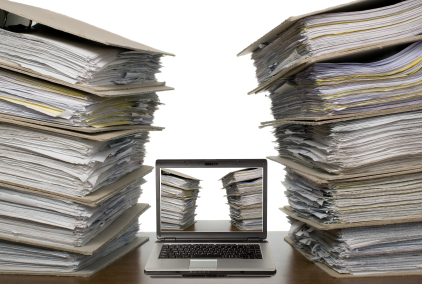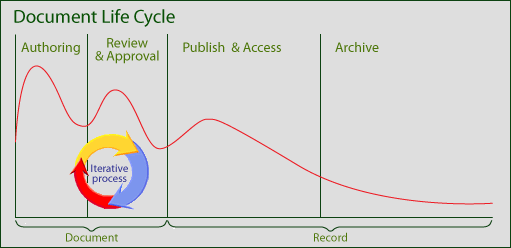ECM-educational program, part 1: electronic document flow and electronic archive
 One of the characteristic trends of our day is the transition to electronic document management and electronic storage of documents. Many organizations are faced with the problem of choosing and implementing ECM systems. In the current situation to make the right choice is very difficult. Substantive analytical publications on ECM-related issues in Russian are practically absent. The lion’s share of available publications is advertising without a hint of any analytics. Of course, on the Internet you can find a lot of materials in foreign languages. But here another difficulty arises: most of the terms from the ECM field do not have exact equivalents in the Russian language, and there is still no consensus on the variants of their translation. The lack of a unified terminology only contributes to various speculations and marketing tricks.
One of the characteristic trends of our day is the transition to electronic document management and electronic storage of documents. Many organizations are faced with the problem of choosing and implementing ECM systems. In the current situation to make the right choice is very difficult. Substantive analytical publications on ECM-related issues in Russian are practically absent. The lion’s share of available publications is advertising without a hint of any analytics. Of course, on the Internet you can find a lot of materials in foreign languages. But here another difficulty arises: most of the terms from the ECM field do not have exact equivalents in the Russian language, and there is still no consensus on the variants of their translation. The lack of a unified terminology only contributes to various speculations and marketing tricks.All the points described above became even more obvious to us when we began to publish ECM-related articles on our blog and receive feedback from readers.
Realizing the complexity of this situation, we decided to prepare a special cycle of articles, which is a kind of ECM educational program. And before we talk about the problems of ECM, it is necessary to clarify the basic concepts.
Terminology issues
ECM stands for Enterprise Content Management (in Russian, this is referred to as “corporate content management”). According to the definition of the Management Association. information and images (AIIM), ECM is a “set of approaches, methods and tools designed to capture, organize, store and search for content and documents related to the organization’s business processes”. It is customary to distinguish the following sections of ECM:
- document management - export / import, version control and security for business documents;
- image imaging management (capture), conversion of paper documents into electronic form;
- Records management - long-term archival storage, development of standards and storage policies, ensuring compliance with legal and industry standards
- email management (e-mail management) - the systematization and storage of information received by the organization by e-mail;
- management of social media (social media management, SMM) - management of information entering the organization in the process of interaction with the external environment through social networks
- Web content management - support for corporate web portals, managing dynamic content and user interaction;
- management of multimedia content (digital assets management, DAM) - storage and systematization of graphic. audio and video materials;
- workflow management - support for business processes, content delivery along routes, assignment of work tasks and states;
- Software designed to perform the operations described above is called ECM-systems. German researcher Ulrich Kampfmeyer identifies five essential components of an ECM system :
- capture (eng. capture) - the transfer of documents from the "paper" - in electronic form;
- document management; records management and storage;
distribution and routing of information;
long-term preservation (i.e. ensuring the security and continuity of access to information).
The analysis shows that the most popular functions of ECM systems are, firstly, document management, and secondly, secure, systematic storage. These functions correspond to two classes of ECM products - document management systems (eng. Document management systems) and records management systems (eng. ERMS, electronic record management systems). In Russia, it is customary to use other terms: “electronic document management system” and “electronic archive system”. What is the difference between the two types of programs? To answer this question, we clarify the content of the concepts “document” (document) and “record” (record).
')
Document and Record
In foreign publications on the problems of ECM and records management, the distinction between document and record is one of the most fundamental. At the same time, in Russian translations this difference is often ignored. In most cases, English document and record are transmitted with the same word “document”, which sometimes creates additional difficulties in understanding translated texts. The question arises: why do the authors of foreign works make this distinction?
To solve all problems, it is necessary to clarify the meaning and features of the use of two terms - document and record.
First we turn to the dictionaries. The Russian “document” and the English document go back to the Latin documentum - sample, certificate, proof. The English word record goes back to the Latin recordare - “remember”.
In the Webster English Dictionary, the meaning of the term document is explained as follows: an original or official paper relied on, or proof of support of something (official or official paper used to substantiate, prove or support something).
The word record gets the following definition in this dictionary: something that recalls or recalls events (something that evokes memories of past events or is somehow related to these events). Interestingly, in the text of the same dictionary entry there are also such meanings of the word record: a combination of known or fixed facts about what or someone, as a rule, belonging to a certain field of activity and systematized in a certain way) and treated as a unit (set of related information units (as in a database), considered as a whole).
In all the cases described, the use of the word record, you can select one common point: it is used to denote evidence of past events. The document can also be used as evidence of the past. But at the same time, many documents serve as evidence of current events or events that should occur in the future. Documents related to current and future events may change. Records of events that have already occurred cannot be changed. In ISO 15489 and MoReq2, the notion of a “record” is defined as follows: Information created, received and supported by an organization or an individual as evidence in accordance with the requirements of the law or business) (Information created, received, and maintained by an organization or person, in pursuance of legal obligations or in the transaction of business.)
Visually, the differences between a document and a record can be displayed on the document life cycle diagram:
Upon receipt of all approvals and visas, the document acquires the final version and becomes a record.
Some documents may well be considered as records: for example, a certificate of completion or a receipt for a payment.
At the same time, recording media can be recording media that are not documents in the traditional sense of the word: graphic images, audio and video recordings, etc. - for example, photos from the exhibition, video and electronic presentation of a report at a conference, voice recording negotiations with the client.
The differences between the document and the record can be summarized in the following small table:Document Record Acts as confirmation of past, present, future events. Acts as confirmation of past events. Can be changed Cannot be changed Has a structured form May not have a structured form
On the basis of the analysis performed, it can be concluded that the document (document) and record (record) are objects of various types, and work with them should be based on different approaches. Accordingly, to work with each type of objects it must be implemented using specialized software - document management systems (document management systems) and records management systems.
Electronic document management and electronic archive
In Russian, the term "records management system" has not yet taken root. Both document management and records management in the majority of publications in Russian are designated by the term “electronic document circulation”. The concept of “document flow” implies, however, that documents are subject to constant changes. Software, positioned as an electronic document management system, should be aimed at automating all operational processes for working with documents.
For the designation of software designed for secure structured storage, another term is widely used in Russia - “electronic archive”. In our country, this term is not used in the sense in which it is commonly used abroad. In English-speaking sources, the concept of archiving means, above all, long-term preservation - ensuring constant access to a document independent of technology changes. In our case, the concept of “electronic archive” is rather an inonym of a records management system . In contrast to electronic document management systems, in electronic archive systems, the main emphasis is still on the other: on automating the storage of business-relevant documents (that is, indicating the activity of the organization and acting as records) of documents. It should also be noted that electronic archive systems are designed to work with much larger (compared to electronic document management systems) volumes of information and have more advanced tools for its search and retrieval.
The differences described above are reflected in the MoReq2 standard:CED (English EDMS) SEA (eng. ERMS) Intended primarily for working with current documentation. May include tools for daily work, but the main focus is on storing business-relevant documents. Include a system of tools for working with different versions of the document. This implies storing only the final version of the document, which is no longer subject to change. You can delete documents Deletion of documents is not allowed, except for a small number of strictly controlled situations.
You can draw an analogy between the choice of ECM-system and the choice of car: for the transport of heavy loads, of course, you can use a passenger car, but ultimately it will be very inefficient and costly; and why to do it if there are trucks that are best adapted for the transportation of heavy oversized cargo? Electronic archive systems are “sharpened” for a fairly narrow class of tasks - but at the same time, due to this narrow specialization, many of them find application in the widest fields.
Speaking about our own electronic archive system , based on the above approach, we note that it belongs to the class of ECM systems, but at the same time is not an electronic document management system: it is designed to solve other (compared to those for which used SED) tasks. Making a clear distinction between the two classes of objects and the two corresponding classes of systems allows us to consider from a new angle many problems from the field of ECM. Such consideration will be carried out in our subsequent publications.
Source: https://habr.com/ru/post/137407/
All Articles